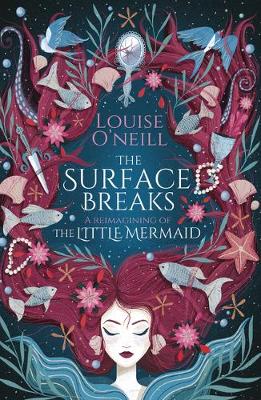The Surface Breaks: a reimagining of The Little Mermaid

By Author / Illustrator
Louise O'Neill, Paola Escobar
Genre
Adventure
Age range(s)
11+
Publisher
Scholastic
ISBN
9781407185538
Format
Hardback
Published
03-05-2018
Synopsis
SHORTLISTED FOR THE SPECSAVERS NATIONAL BOOK AWARDS Think you know the story of The Little Mermaid? Think again... This is a book with the darkest of undercurrents, full of rage and rallying cries: storytelling at its most spellbinding. Deep beneath the sea, off the cold Irish coast, Gaia is a young mermaid who dreams of freedom from her controlling father. On her first swim to the surface, she is drawn towards a human boy. She longs to join his carefree world, but how much will she have to sacrifice? What will it take for the little mermaid to find her voice? Hans Christian Andersen's original fairy tale is reimagined through a searing feminist lens, with the stunning, scalpel-sharp writing and world building that has won Louise her legions of devoted fans.
Reviews
Laura
A fantasy story that is perhaps something of a surprising departure from her recent controversial YA novels 'Only Ever Yours' and 'Asking for it', Louise O'Neill's latest novel is a re-imagining of Hans Christian Andersen's Little Mermaid story. The Disney version of the story may be the more familiar to most contemporary young readers but the author is interested in a much darker and feminist interpretation of the classic fairy tale. The action initially focuses on teenage mermaid Gaia (also known as Muirgen) and the other members of the royal mer family to which she belongs. Gala dreams of becoming a human particularly when on her 15th birthday she meets, rescues from drowning and instantly falls in love with human Oliver, but her father has betrothed her to a much older merman, Zale, and she has little if any free will or choice. She also wishes to resolve the mystery fate of her missing mother who by all accounts abandoned her and her five sisters for the love of a human. Gaia decides to escape the repressive control of her father the Sea King and her life underwater in the Sea Kingdom where women and girls are only valued for their looks and obedience, as well as avoiding the regular unwelcome sexual assaults made by Zale. She is told that only the Sea Witch in the Shadowlands has the power to grant her wish of having legs so she can live and love as a human. After the fairy tale style and symbolism of the first half of this story, the second half outlines her new life as a mute (the price she pays Cito the Sea Witch for a pair of legs) living amongst Oliver and his wealthy family and friends as a human. She has a month in which to make him fall in love with her and kiss her if she is to survive. Whilst having lost her beautiful singing voice she has gained gracefulness as a dancer (hence her new name of Grace) although she suffers excruciating pain as her human legs begin to waste away. Here too the brutality of men and the dismissal of women in society continues. Human males are seen just like mermen to be brutish, obsessed with power, money and politics whilst women are here too expected to be silent and appear attractive. There are some strong female characters - notably Ceto, the Sea witch and Eleanor, Oliver's mother, but Gaia ultimately has paid the price for lusting after a human and she recognises that sacrificing herself for any man is not worth it. The feminist message and stereotyping of girls and men at times hits you over the head, and can be obvious and unsubtle. Both the human and the underwater world are seen as patriarchies where girls are regarded as powerless, owned by men and valued only for their looks, whilst men, with a few exceptions, are portrayed as violent, power seeking, and domineering. I am not completely sure to whom this book would appeal. Young teenagers who enjoy the fantasy genre perhaps yet there is some swearing, sexual assault, brutality and considerable violence which might not be regarded as entirely suitable for young teens who, perhaps attracted by the cover, are expecting a harmless, magical fairy story about mermaids. However, this is a return to the original style and message of the often frightening and moralising fairy tale genre. The original Andersen classic is itself a far cry from the Disney Ariel animated musical film (although Gaia is described as having red hair and blue eyes like the cartoon Ariel!) and this dark, dystopian re-telling uses it as a vehicle to highlight gender stereotyping and the beauty myth. Older teenagers who have enjoyed Louise O'Neill's previous books, may find the fairytale references unfamiliar. 320 pages / Ages 13+ / Reviewed by Laura Taylor, school librarian.
Suggested Reading Age 11+
Other titles
-
 Westfallen: What if you had to stop Germany winning WWII? A thrilling race-against-time adventure
11+ Adventure 20250327
Westfallen: What if you had to stop Germany winning WWII? A thrilling race-against-time adventure
11+ Adventure 20250327
-
 Heist Royale: The enemies-to-lovers sequel to Thieves' Gambit
11+ Adventure 20241112
Heist Royale: The enemies-to-lovers sequel to Thieves' Gambit
11+ Adventure 20241112
-
 Captain of Fates (Twin Crowns, Book 4)
11+ Adventure 20250424
Captain of Fates (Twin Crowns, Book 4)
11+ Adventure 20250424
-
 Splinters
11+ Suspense & Thrillers 20240613
Splinters
11+ Suspense & Thrillers 20240613
